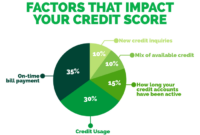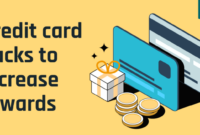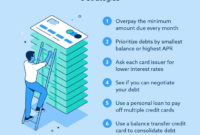How to manage credit card debt is a crucial topic that affects many individuals. Dive into this comprehensive guide filled with strategies, tips, and budgeting advice to take control of your finances.
Explore the best methods to pay off debt, understand the importance of budgeting, and learn how to avoid common pitfalls in managing credit card debt.
Understanding Credit Card Debt: How To Manage Credit Card Debt
Credit card debt refers to the amount of money owed to a credit card issuer for purchases made using the card. This debt accumulates when cardholders carry a balance from one month to the next, incurring interest charges. Understanding credit card debt is essential, as it can have significant implications on an individual’s financial health.
How Credit Card Interest Works
Credit card interest is calculated based on the average daily balance of the cardholder’s account. The annual percentage rate (APR) determines the interest rate charged on the outstanding balance. When the balance is not paid in full each month, interest accrues, leading to higher overall debt. For example, with an APR of 18%, a $1,000 balance would accrue $15 in interest in one month.
Consequences of Carrying High Credit Card Balances
Carrying high credit card balances can lead to several negative consequences. These include paying more in interest over time, damaging credit scores, and limiting financial flexibility. High balances can also increase the risk of defaulting on payments, leading to additional fees and penalties.
Accumulation of Credit Card Debt Over Time
Credit card debt can accumulate rapidly over time, especially when only making minimum payments. For instance, a $5,000 balance with an 18% APR and a 2% minimum payment will take over 17 years to pay off, with total interest paid exceeding $5,000. This highlights the importance of managing credit card debt responsibly to avoid long-term financial strain.
Strategies to Manage Credit Card Debt
When it comes to managing credit card debt, there are several strategies that individuals can implement to regain control of their finances and work towards becoming debt-free. Here are some effective approaches to pay off credit card debt:
The Snowball Method
The snowball method involves paying off your smallest credit card debt first while making minimum payments on all other debts. Once the smallest debt is paid off, you move on to the next smallest debt, and so on. This method can provide a sense of accomplishment early on and motivate you to continue tackling larger debts.
The Avalanche Method
Contrary to the snowball method, the avalanche method focuses on paying off the debt with the highest interest rate first. By prioritizing high-interest debts, you can save money on interest payments in the long run and pay off your debts more efficiently.
Debt Consolidation
Debt consolidation involves combining multiple debts into a single loan with a lower interest rate. This can simplify your debt repayment process and potentially reduce the total amount of interest paid over time. However, it’s essential to carefully consider the terms and fees associated with debt consolidation options.
Negotiating with Credit Card Companies
One effective strategy for managing credit card debt is negotiating with credit card companies for lower interest rates. By explaining your financial situation and demonstrating a willingness to repay your debts, you may be able to secure a reduced interest rate, making it easier to pay off your debt faster.
Creating a Budget and Financial Plan

Creating a budget is a crucial step in managing credit card debt effectively. It allows you to track your income, expenses, and debt repayments, helping you prioritize your financial goals and make informed decisions.
Steps to Create a Budget that Prioritizes Debt Repayment, How to manage credit card debt
- Start by calculating your total monthly income after taxes.
- List all your fixed expenses, such as rent, utilities, and minimum debt payments.
- Identify variable expenses like groceries, dining out, and entertainment.
- Allocate a portion of your income towards debt repayment, focusing on high-interest credit card balances first.
- Set realistic goals and track your progress regularly to stay on course.
Understanding the 50/30/20 Rule for Budgeting
The 50/30/20 rule suggests allocating 50% of your income to necessities, 30% to discretionary spending, and 20% to savings and debt repayment.
- By following this rule, you can ensure that a significant portion of your income goes towards debt repayment, helping you reduce your credit card balances efficiently.
- Adjust the percentages based on your financial situation and debt repayment goals.
Significance of Tracking Expenses and Identifying Areas for Saving
- Tracking your expenses allows you to understand where your money is going and identify areas where you can cut back to allocate more towards debt repayment.
- Consider using budgeting apps or spreadsheets to monitor your spending habits and make informed decisions.
- Audit your expenses regularly to identify unnecessary purchases and prioritize debt repayment.
Avoiding Common Pitfalls

When it comes to managing credit card debt, there are common mistakes that people often make which can hinder their progress. It’s important to be aware of these pitfalls in order to effectively tackle your debt and improve your financial situation.
Dangers of Making Minimum Payments
Making only the minimum payments on your credit cards may seem like a manageable way to handle your debt, but it can actually lead to long-term financial struggles. By only paying the minimum, you end up accruing more interest over time, making it harder to pay off the principal balance. This can result in a cycle of debt that becomes increasingly difficult to break free from.
Avoiding New Debt
One crucial aspect of managing credit card debt is to avoid accumulating new debt. Taking on additional debt while trying to pay off your existing balances can sabotage your efforts and put you in a worse financial position. It’s important to resist the temptation to use your credit cards for unnecessary purchases and focus on reducing your debt instead.
Changing Spending Habits
In order to prevent further accumulation of credit card debt, it’s essential to reassess your spending habits and make necessary adjustments. This may involve creating a budget, tracking your expenses, and prioritizing essential purchases over discretionary spending. By changing your approach to money management, you can avoid falling back into the cycle of debt and work towards a more stable financial future.
In conclusion, taking proactive steps to manage credit card debt is essential for financial stability. By implementing the strategies Artikeld here, you can work towards a debt-free future and secure your financial well-being.
Finish your research with information from Best travel credit cards.



